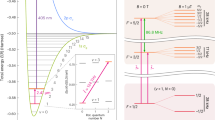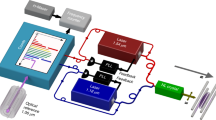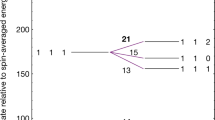Abstract
Sympathetic cooling of trapped ions has been established as a powerful technique for the manipulation of non-laser-coolable ions1,2,3,4. For molecular ions, it promises vastly enhanced spectroscopic resolution and accuracy. However, this potential remains untapped so far, with the best resolution achieved being not better than 5 × 10−8 fractionally, due to residual Doppler broadening being present in ion clusters even at the lowest achievable translational temperatures5. Here we introduce a general and accessible approach that enables Doppler-free rotational spectroscopy. It makes use of the strong radial spatial confinement of molecular ions when trapped and crystallized in a linear quadrupole trap, providing the Lamb–Dicke regime for rotational transitions. We achieve a linewidth of 1 × 10−9 fractionally and 1.3 kHz absolute, an improvement of ≃50-fold over the previous highest resolution in rotational spectroscopy. As an application, we demonstrate the most precise test of ab initio molecular theory and the most accurate (1.3 × 10−9) determination of the proton mass using molecular spectroscopy. The results represent the long overdue extension of Doppler-free microwave spectroscopy of laser-cooled atomic ion clusters6 to higher spectroscopy frequencies and to molecules. This approach enables a wide range of high-accuracy measurements on molecules, both on rotational and, as we project, vibrational transitions.
This is a preview of subscription content, access via your institution
Access options
Access Nature and 54 other Nature Portfolio journals
Get Nature+, our best-value online-access subscription
$29.99 / 30 days
cancel any time
Subscribe to this journal
Receive 12 print issues and online access
$209.00 per year
only $17.42 per issue
Buy this article
- Purchase on Springer Link
- Instant access to full article PDF
Prices may be subject to local taxes which are calculated during checkout




Similar content being viewed by others
References
Raizen, M., Gilligan, J., Bergquist, J., Itano, W. & Wineland, D. Ionic crystals in a linear Paul trap. Phys. Rev. A 45, 6493 –6501 (1992).
Waki, I., Kassner, S., Birkl, G. & Walther, H. Observation of ordered structures of laser-cooled ions in a quadrupole storage ring. Phys. Rev. Lett. 68, 2007–2010 (1992).
Bowe, P. et al. Sympathetic crystallization of trapped ions. Phys. Rev. Lett. 82, 2071–2074 (1999).
Barrett, M. D. et al. Sympathetic cooling of 9Be+ and 24Mg+ for quantum logic. Phys. Rev. A 68, 042302 (2003).
Bressel, U. et al. Manipulation of individual hyperfine states in cold trapped molecular ions and application to HD+ frequency metrology. Phys. Rev. Lett. 108, 183003 (2012).
Berkeland, D. J., Miller, J. D., Bergquist, J. C., Itano, W. M. & Wineland, D. J. Laser-cooled mercury ion frequency standard. Phys. Rev. Lett. 80, 2089–2092 (1998).
Townes, C. & Schawlow, A. Microwave Spectroscopy (Dover, New York, NY, 1975).
Jusko, P., Asvany, O., Wallerstein, A.-C., Brünken, S. & Schlemmer, S. Two-photon rotational action spectroscopy of cold OH− at 1 ppb accuracy. Phys. Rev. Lett. 112, 253005 (2014).
Schiller, S. & Korobov, V. Test of time-dependence of the electron and nuclear masses with ultracold molecules. Phys. Rev. A. 71, 032505 (2005).
Shelkovnikov, A., Butcher, R. J., Chardonnet, C. & Amy-Klein, A. Stability of the Proton-to-Electron Mass Ratio. Phys. Rev. Lett. 100, 150810 (2008).
Uzan, J.-P. Varying constants, gravitation and cosmology. Living Rev. Relativ. 14, 2 (2011).
Godun, R. M. et al. Frequency ratio of two optical clock transitions in 171Yb+ and constraints on the time variation of fundamental constants. Phys. Rev. Lett. 113, 210801 (2014).
Huntemann, N. et al. Improved limit on a temporal variation of m p/m e from comparisons of Yb+ and Cs atomic clocks. Phys. Rev. Lett. 113, 210802 (2014).
Roth, B. et al. in Precision Physics of Simple Atoms and Molecules. Lecture Notes in Physics Vol. 745 (ed. Karshenboim S. G.) 205–232 (Springer, Berlin, Heidelberg, 2008).
Koelemeij, J. C. J., Roth, B., Wicht, A., Ernsting, I. & Schiller, S. Vibrational spectroscopy of HD+ with 2-ppb accuracy. Phys. Rev. Lett. 98, 173002 (2007).
Biesheuvel, J. et al. Probing QED and fundamental constants through laser spectroscopy of vibrational transitions in HD+. Nat. Comm. 7, 10385 (2016).
Winton, R. S. & Gordy, W. High-precision millimeter-wave spectroscopy with Lamb dip. Phys. Lett. A. 32, 219–220 (1970).
Cazzoli, G. & Dore, L. Observation of crossing resonances in the hyperfine structure of the J = 1 ← 0 transition of DC15N. J. Mol. Spectrosc. 143, 231–236 (1990).
Winnewisser, G., Belov, S. P., Klaus, T. & Schieder, R. Sub-Doppler measurements on the rotational transitions of carbon monoxide. J. Mol. Spectrosc. 184, 468–472 (1997).
Cazzoli, G. & Puzzarini, C. Sub-Doppler resolution in the THz frequency domain: 1 kHz accuracy at 1 THz by exploiting the Lamb-dip technique. J. Phys. Chem. A 117, 13759–13766 (2013).
Dicke, R. H. The effect of collisions upon the Doppler width of spectral lines. Phys. Rev. 89, 472–473 (1953).
Germann, M., Tong, X. & Willitsch, S. Observation of dipole-forbidden transitions in sympathetically cooled, state-selected, homonuclear diatomic molecular ions. Nat. Phys. 10, 820–824 (2014).
Wolf, F. et al. Non-destructive state detection for quantum logic spectroscopy of molecular ions. Nature 530, 457–460 (2016).
Chou, C. et al. Preparation and coherent manipulation of pure quantum states of a single molecular ion. Nature 545, 203–207 (2017).
Bakalov, D., Korobov, V. & Schiller, S. Magnetic field effects in the transitions of the HD+ molecular ion and precision spectroscopy. J. Phys. B 44, 025003 (2011); corrigendum 45, 049501 (2012).
Mohr, P. J., Newell, D. B. & Taylor, B. N. CODATA recommended values of the fundamental physical constants: 2014. Rev. Mod. Phys. 88, 035009 (2016).
Korobov, V. I., Hilico, L. & Karr, J. P. Theoretical transition frequencies beyond 0.1 ppb accuracy in H2 +, HD+, and antiprotonic helium. Phys. Rev. A 89, 032511 (2014).
Korobov, V. I., Hilico, L. & Karr, J.-P. mα 7-order corrections in the hydrogen molecular ions and antiprotonic helium. Phys. Rev. Lett. 112, 103003 (2014).
Korobov, V. I., Koelemeij, J. C. J., Hilico, L. & Karr, J.-P. Theoretical hyperfine structure of the molecular hydrogen ion at the 1 ppm level. Phys. Rev. Lett. 116, 053003 (2016).
Korobov, V. I., Hilico, L. & Karr, J.-P. Fundamental transitions and ionization energies of the hydrogen molecular ions with few ppt uncertainty. Phys. Rev. Lett. 118, 233001 (2017).
Hansen, A. K. et al. Efficient rotational cooling of Coulomb-crystallized molecular ions by a helium buffer gas. Nature 508, 76–79 (2014).
Schiller, S., Kortunov, I., Hernández Vera, M., Gianturco, F. & da Silva, H. Quantum state preparation of homonuclear molecular ions enabled via a cold buffer gas: An ab initio study for the H2 + and the D2 + case. Phys. Rev. A 95, 043411 (2017).
Bakalov, D., Korobov, V. I. & Schiller, S. High-precision calculation of the hyperfine structure of the HD+ ion. Phys. Rev. Lett. 97, 243001 (2006).
Shen, J., Borodin, A. & Schiller, S. A simple method for characterization of the magnetic field in an ion trap using Be+ ions. Eur. Phys. J. D. 68, 359 (2014).
Hornekær, L., Kjærgaard, N., Thommesen, A. M. & Drewsen, M. Structural properties of two-component Coulomb crystals in linear Paul traps. Phys. Rev. Lett. 86, 1994 (2001).
Zhang, C. B., Offenberg, D., Roth, B., Wilson, M. A. & Schiller, S. Molecular-dynamics simulations of cold single-species and multispecies ion ensembles in a linear Paul trap. Phys. Rev. A 76, 012719 (2007).
Cramér, H. Random Variables and Probability Distributions (Cambridge Univ. Press, Cambridge, 1970).
Berkeland, D. J., Miller, J. D., Bergquist, J. C., Itano, W. M. & Wineland, D. J. Minimization of ion micromotion in Paul trap. J. Appl. Phys. 83, 5025–5033 (1998).
Blythe, P., Roth, B., Fröhlich, U., Wenz, H. & Schiller, S. Production of ultracold trapped molecular hydrogen ions. Phys. Rev. Lett. 95, 183002 (2005).
Schneider, T., Roth, B., Duncker, H., Ernsting, I. & Schiller, S. All-optical preparation of molecular ions in the rovibrational ground state. Nat. Phys. 6, 275–278 (2010).
Shen, J., Borodin, A., Hansen, M. & Schiller, S. Observation of a rotational transition of trapped and sympathetically cooled molecular ions. Phys. Rev. A 85, 032519 (2012).
Schiller, S., Roth, B., Lewen, F., Ricken, O. & Wiedner, M. Ultra-narrow-linewidth continuous-wave THz sources based on multiplier chains. Appl. Phys. B 95, 55–61 (2009).
Wiens, E., Nevsky, A. Y. & Schiller, S. Resonator with ultrahigh length stability as a probe for equivalence-principle-violating physics. Phys. Rev. Lett. 117, 271102 (2016).
Wiens, E. et al. A silicon single-crystal cryogenic optical resonator. Opt. Lett. 39, 3242–3245 (2014).
Nevsky, A. Y. et al. Robust frequency stabilization of multiple spectroscopy lasers with large and tunable offset frequencies. Opt. Lett. 38, 4903–4906 (2013).
Bakalov, D. & Schiller, S. The electric quadrupole moment of molecular hydrogen ions and their potential for a molecular ion clock. Appl. Phys. B 114, 213–230 (2014).
Schiller, S., Bakalov, D., Bekbaev, A. K. & Korobov, V. I. Static and dynamic polarizability and the Stark and blackbody-radiation frequency shifts of the molecular hydrogen ions. Phys. Rev. A 89, 052521 (2014).
Constantin, F. L. THz/infrared double resonance two-photon spectroscopy of HD+ for determination of fundamental constants. Atoms 5, 38 (2017).
Acknowledgements
This work has been partially funded by Deutsche Forschungsgemeinschaft project Schi 431/19-1. V.I.K. acknowledges support from the Russian Foundation for Basic Research under grant no. 15-02-01906-a. We thank U. Rosowski for important assistance with the frequency comb, A. Nevsky for assistance with a laser system, E. Wiens for characterizing H-maser instability, D. Iwaschko, R. Gusek and P. Dutkiewicz for electronics development, J. Scheuer and M. Melzer for assistance, and S. Schlemmer (Universität zu Köln) for equipment loans. We thank K. Brown (Georgia Institute of Technology) for useful discussions and suggestions.
Author information
Authors and Affiliations
Contributions
S.A. and M.G.H. developed the apparatus and performed the experiments; S.A., M.G.H. and S.S. analysed the data; S.A., S.S. and V.I.K. performed theoretical calculations; S.S. conceived the study, supervised the work and wrote the paper.
Corresponding author
Ethics declarations
Competing interests
The authors declare no competing interests.
Additional information
Publisher’s note: Springer Nature remains neutral with regard to jurisdictional claims in published maps and institutional affiliations.
Supplementary information
Supplementary Information
zero chapters, 2 figures, 0 references
Rights and permissions
About this article
Cite this article
Alighanbari, S., Hansen, M.G., Korobov, V.I. et al. Rotational spectroscopy of cold and trapped molecular ions in the Lamb–Dicke regime. Nature Phys 14, 555–559 (2018). https://doi.org/10.1038/s41567-018-0074-3
Received:
Accepted:
Published:
Issue Date:
DOI: https://doi.org/10.1038/s41567-018-0074-3
This article is cited by
-
Test of charged baryon interaction with high-resolution vibrational spectroscopy of molecular hydrogen ions
Nature Physics (2023)
-
Proton–electron mass ratio by high-resolution optical spectroscopy of ion ensembles in the resolved-carrier regime
Nature Physics (2021)
-
Quantum entanglement between an atom and a molecule
Nature (2020)
-
Laser spectroscopy of pionic helium atoms
Nature (2020)
-
Precise test of quantum electrodynamics and determination of fundamental constants with HD+ ions
Nature (2020)



